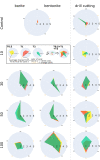Exploring time series of hyperspectral images for cold water coral stress response analysis
- PMID: 35939502
- PMCID: PMC9359567
- DOI: 10.1371/journal.pone.0272408
Exploring time series of hyperspectral images for cold water coral stress response analysis
Abstract
Hyperspectral imaging (HSI) is a promising technology for environmental monitoring with a lot of undeveloped potential due to the high dimensionality and complexity of the data. If temporal effects are studied, such as in a monitoring context, the analysis becomes more challenging as time is added to the dimensions of space (image coordinates) and wavelengths. We conducted a series of laboratory experiments to investigate the impact of different stressor exposure patterns on the spectrum of the cold water coral Desmophyllum pertusum. 65 coral samples were divided into 12 groups, each group being exposed to different types and levels of particles. Hyperspectral images of the coral samples were collected at four time points from prior to exposure to 6 weeks after exposure. To investigate the relationships between the corals' spectral signatures and controlled experimental parameters, a new software tool for interactive visual exploration was developed and applied, the HypIX (Hyperspectral Image eXplorer) web tool. HypIX combines principles from exploratory data analysis, information visualization and machine learning-based dimension reduction. This combination enables users to select regions of interest (ROI) in all dimensions (2D space, time point and spectrum) for a flexible integrated inspection. We propose two HypIX workflows to find relationships in time series of hyperspectral datasets, namely morphology-based filtering workflow and embedded driven response analysis workflow. With these HypIX workflows three users identified different temporal and spatial patterns in the spectrum of corals exposed to different particle stressor conditions. Corals exposed to particles tended to have a larger change rate than control corals, which was evident as a shifted spectrum. The responses, however, were not uniform for coral samples undergoing the same exposure treatments, indicating individual tolerance levels. We also observed a good inter-observer agreement between the three HyPIX users, indicating that the proposed workflow can be applied to obtain reproducible HSI analysis results.
Conflict of interest statement
The study was financed by Equinor. Equinor Ventures is one of the main shareholders of Ecotone AS. IMH is a minor shareholder of Ecotone AS. Ecotone AS is the owner of patent no. NO/EP2286194 titled “Underwater Hyperspectral Imaging“. Ecotone sells scientific instruments for underwater use under the product name Underwater Hyperspectral Imager (UHI). Ecotone AS has two pending patent applications, IMH is involved as inventor. Equinor funded a project at the Biodata Mining Group, but these funding was in no way linked to the outcome of this study. This does not alter our adherence to all the policies on sharing data and materials. All other authors declare no competing interests.
Figures






References
-
- Goetz A. Three decades of hyperspectral remote sensing of the Earth: A personal view. Remote Sensing of Environment. 2009;113. doi: 10.1016/j.rse.2007.12.014 - DOI
-
- Adão T, Hruška J, Pádua L, Bessa J, Peres E, Morais R, et al.. Hyperspectral imaging: A review on UAV-based sensors, data processing and applications for agriculture and forestry. Remote Sensing. 2017;9(11):1110. doi: 10.3390/rs9111110 - DOI
-
- Liu Y, Pu H, Sun DW. Hyperspectral imaging technique for evaluating food quality and safety during various processes: A review of recent applications. Trends in food science & technology. 2017;69:25–35. doi: 10.1016/j.tifs.2017.08.013 - DOI
-
- Lu Y, Huang Y, Lu R. Innovative hyperspectral imaging-based techniques for quality evaluation of fruits and vegetables: A review. Applied Sciences. 2017;7(2):189. doi: 10.3390/app7020189 - DOI
Publication types
MeSH terms
Substances
LinkOut - more resources
Full Text Sources

